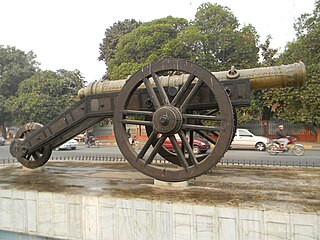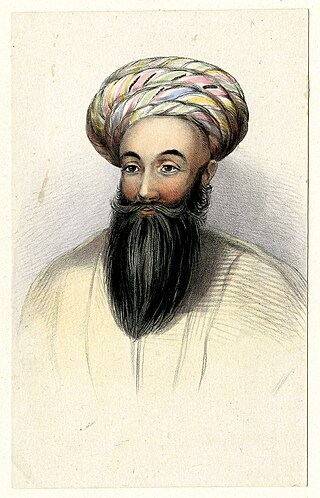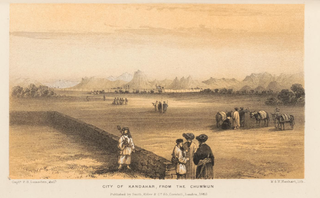
Dost Mohammad Khan Barakzai, nicknamed the Amir-i Kabir, was the founder of the Barakzai dynasty and one of the prominent rulers of Afghanistan during the First Anglo-Afghan War. With the decline of the Durrani dynasty, he became the Emir of Afghanistan in 1826. An ethnic Pashtun, he belonged to the Barakzai tribe. He was the 11th son of Payinda Khan, chief of the Barakzai Pashtuns, who was killed in 1799 by King Zaman Shah Durrani.

Sardar Mohammad Azim Khan Barakzai was a Pashtun noble who served as Afghan governor of Kashmir (1812–1819). He was the second son of the Barakzai chief Payinda Sarfaraz Khan, while his elder brother Fateh Khan was kingmaker and Vizier to Mahmud Shah Durrani. He was one of 21 brothers from eight mothers including his half-brother Dost Mohammad Khan who would later become Emir of Afghanistan.

Sher Singh was the fourth Maharaja of the Sikh Empire. Elder of the twins of Maharaja Ranjit Singh, founder of the Sikh Empire and Maharani Mehtab Kaur. His reign began on 18 January 1840 following his assault on Lahore which ended the brief regency of Maharani Chand Kaur. He was assassinated on 15 September 1843 by Ajit Singh Sandhawalia.

The Sikh Empire was a regional power based in the Punjab region of the Indian subcontinent. It existed from 1799, when Maharaja Ranjit Singh captured Lahore, to 1849, when it was defeated and conquered by the British East India Company in the Second Anglo-Sikh War. It was forged on the foundations of the Khalsa from a collection of autonomous misls. At its peak in the 19th century, the empire extended from Gilgit and Tibet in the north to the deserts of Sindh in the south and from the Khyber Pass in the west to the Sutlej in the east as far as Oudh. It was divided into four provinces: Lahore, which became the Sikh capital; Multan; Peshawar; and Kashmir from 1799 to 1849. Religiously diverse, with an estimated population of 4.5 million in 1831, it was the last major region of the Indian subcontinent to be annexed by the British Empire.

Hari Singh Nalwa was the commander-in-chief of the Sikh Khalsa Fauj, the army of the Sikh Empire. He is known for his role in the conquests of Kasur, Sialkot, Attock, Multan, Kashmir, Peshawar and Jamrud. Hari Singh Nalwa was responsible for expanding the frontier of Sikh Empire to beyond the Indus River right up to the mouth of the Khyber Pass. At the time of his death, Jamrud constituted the western boundary of the Empire.

The Zamzama Gun also known as Kim’s Gun or Bhangianwali Toap is a large-bore cannon. It was cast in about 1757 in Lahore during the Durrani Empire. It is currently on display in front of the Lahore Museum in Lahore, Pakistan.

Diwan Mokham Chand was one of the chief commanders of the Sikh Empire. He conquered Attock from the Durrani Afghans in 1813 and subdued the Rajputs in the Hills of Himachal and in Jammu at Jasrota, Chamba, and Basroli. He also commanded one of the early Sikh expeditions to conquer Kashmir that ended in failure due to bad weather blocking the passes to the valley. Mokham Chand was born in a Hindu Khatri family.

The Battle of Nowshera was fought in Nowshera in March 1823 collectively by the Yusufzai Afghans, supported by the Peshawar sardars, alongside Azim Khan Barakzai, the Afghan governor of Peshawar, where they would face the Sikh armies led by Maharaja Ranjit Singh. Azim Khan was a half-brother of Dost Mohammad Khan, the future ruler of Kabul, and later Afghanistan. The battle was a victory for the Sikhs over Azim Khan's armies, a result which allowed the Sikhs to begin their occupation of the Peshawar Valley.

Sardar Charat Singh, also romanised as Charhat Singh, was the founder of Sukerchakia Misl, father of Mahan Singh, and the grandfather of Ranjit Singh, the first Maharaja of the Sikh Empire. He distinguished himself at an early age in campaigns against Ahmad Shah Abdali and along with 150 horsemen split from the Singhpuria Misl to establish the Sukerchakia Misl, a separate grouping with its distinct guerilla militia.

The Battle of Attock took place on 13 July 1813 between the Sikh Empire and the Durrani Empire. The battle was the first significant Sikh victory over the Durranis.
The siege of Multan began in March 1818 and lasted until 2 June 1818 as part of the Afghan–Sikh Wars, and saw the Sikh Empire capture Multan from the Durrani Empire.
The Battle of Shopian took place on 3 July 1819 between an expeditionary force from the Sikh Empire and Jabbar Khan, the governor of the Kashmir Valley province of the Durrani Empire. It was the decisive battle during the Sikh expedition into Kashmir in 1819.

Misr Diwan Chand was a notable officer and a powerful general of Maharaja Ranjit Singh's reign. From a petty clerk he rose to the position of chief of artillery and commander-in-chief of the armies that conquered Multan and Kashmir and also served as the Commander-in-Chief of the Khalsa Army from 1816 to 1825.

The Sikh Rule in Lahore initiated from the conquest and rule of the Sikh Misls and extended till the Sikh Empire of Ranjit Singh which ended in 1849. The Sikhs began gaining power following the decline of the Mughal Empire in Punjab and consisted of a collection of autonomous Punjabi Misls, which were governed by Misldars, mainly in the Punjab region.

The Afghan–Sikh wars spanned from 1748 to 1837 in the Indian subcontinent, and saw multiple phases of fighting between the Durrani Empire and the Sikh Empire, mainly in and around Punjab region. The conflict's origins stemmed from the days of the Dal Khalsa, and continued after the Emirate of Kabul succeeded the Durrani Empire.

Shah Shujah Durrani was ruler of the Durrani Empire from 1803 to 1809. He then ruled from 1839 until his death in 1842. Son of Timur Shah Durrani, Shujah was of the Sadduzai line of the Abdali group of ethnic Pashtuns. He became the fifth King of the Durrani Empire.
The Battle of Hasan Abdal took place on June 7, 1813, between the Sikhs led by Bhayya Ram Singh and Afghans led by Fateh Khan Barakzai at Hasan Abdal.
The Kashmir expedition took place in 1814 after the battle of Attock. Ranjit Singh began planning to invade Kashmir, leading to the Sikh invasion led by Hari Singh Nalwa and Ram Dayal.

Beginning in January 1833, Shah Shujah Durrani, the deposed Afghan emperor, led an expedition to re-claim his throne. Raising a force while in exile in the Sikh Empire, he marched through Sindh to Kandahar, besieging it from 10 May 1834 until 1 July 1834. Shah Shujah would be defeated by the Barakzai rulers of Kandahar and Kabul.
Fateh Khan Barakzai or Wazir Fateh Khan or simply, Fateh Khan, was Wazir of the Durrani Empire during the reign of Mahmud Shah Durrani until his torture and execution at the hands of Kamran Shah Durrani, the son of the ruler of the Durrani Empire, and Mahmud Shah Durrani, and other prominent conspirators such as Ata Mohammad Khan. Fateh Khan was of the Barakzai tribe, and his death led to his tribe revolting and the eventual deposition of Mahmud Shah Durrani.














